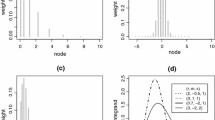Summary
Previous work in stochastic frontier models with exponentially distributed one-sided errors using both Gibbs sampling and Monte Carlo integration with importance sampling reveals the enormous computational gains that can be achieved using the former. This paper takes up inference in another interesting class of stochastic frontier models, those with truncated normal one-sided error terms, and shows that posterior simulation involves drawing from standard or log-concave distributions, implying that Gibbs sampling is an efficient solution to the Bayesian integration problem. The sampling behavior of the Bayesian procedure is investigated using a Monte Carlo experiment. The method is illustrated using US airline data.

Similar content being viewed by others
Notes
2 Greene’s (1990) normal-gamma frontier model also allows for the possibility that the modal value is away from zero. For a criticism of this model see Ritter and Simar (1997). This criticism applies to the truncated normal model as well.
3 The Erlang distribution is the gamma under the assumption that the shape parameter is integer.
4 Geweke’s (1991) method (based on acceptance sampling) is generally the most efficient way to draw random numbers from truncated normal or Student-t distributions. However, I have found that inversion of the cdf is more efficient when one uses computer languages based on vector arithmetic, like “gauss”. The reason is that Geweke’s technique cannot be “vectorized”.
5 Fernandez, Osiewalski and Steel (1997) show that an informative prior for σ is needed to ensure a proper posterior distribution. See also Ritter (1993) and Ritter and Simar (1993).
6 van den Broeck et al. (1994, pp.286–287) have devised an elicitation strategy based on what they call r*, the prior median efficiency. Their joint prior for ψ and ω is the same as in this paper. According to this elicitation procedure, values of q′ near 0.1 or 0.2 that would imply 80–90% prior median efficiency are very close to what would come out as the result of their procedure, for small values of a0. Larger values of ao are not consistent with such prior median efficiency.
7 These results are available on request.
8 This can be shown using Johnson, Kotz and Balakrishnan (1994, formula 13.135) who provide the variance of a normal random variable truncated to a given interval.
References
Aigner, D., Knox-Lovell, C.A. and Schmidt, P., 1977, Formulation and estimation of stochastic frontier production function models. Journal of Econometrics, 6, 21–37.
Bauer, P.W., 1990, Recent developments in the econometric estimation of frontiers. Journal of Econometrics, 46, 39–56.
van den Broeck, J., Koop, G., Osiewalski, J. and Steel, M.F.J., 1994, Stochastic frontier models: A Bayesian perspective. Journal of Econometrics, 61, 273–303.
Brooks S.P., Deilaportas, P. and Roberts, G.O., 1997, A total variation method for diagnosing convergence of MCMC algorithms. Journal of Computational and Graphical Statistics, forthcoming.
Brooks, S.P. and Gelman, A., 1997, Alternative methods for monitoring convergence of iterative simulations. Journal of Computational and Graphical Statistics, forthcoming.
Brooks, S.P. and Roberts, G.O., 1998, Assessing convergence of Markov Chain Monte Carlo algorithms, manuscript, School of Mathematics, University of Bristol.
Fernandez, C., Osiewalski, J., and Steel, M.F.J., 1997, On the use of panel data in stochastic frontier models. Journal of Econometrics, 79, 169–193.
Gelfand, A.E., and Smith, A.F.M., 1990, Sampling based approaches to calculating marginal densities. Journal of the American Statistical Association, 85, 398–409.
Author information
Authors and Affiliations
Appendix. Some properties of posterior conditional distributions of ω −1 and ψ}
Appendix. Some properties of posterior conditional distributions of ω −1 and ψ}
The posterior conditional distribution of ω is given by (8). A change of variables to v = ω−1 yields the following distribution for v:
Taking logarithms and denoting Q(v) = ln p(v ∣.) we have
Setting to zero and multiplying by v yields the quadratic equation
This quadratic has a unique positive root, which determines an optimum of the posterior conditional distribution of v. Moreover to prove that this distribution is log-concave, we consider
which is negative for all admissible values of v.
Regarding now the posterior conditional distribution of ψ it is given by (7). Assuming that the prior is log-concave consider concavity of the logarithm of the first term in the product of (7), namely
whose second derivative is
after taking into account that dϕ(ψ)/dψ = −ψϕ(ψ). It can be easily shown that the function in parentheses is always non-positive, which proves log-concavity of the posterior conditional distribution of ψ.
Rights and permissions
About this article
Cite this article
Tsionas, E.G. Posterior Analysis of Stochastic Frontier Models with Truncated Normal Errors. Computational Statistics 16, 559–575 (2001). https://doi.org/10.1007/s180-001-8330-0
Published:
Issue Date:
DOI: https://doi.org/10.1007/s180-001-8330-0




